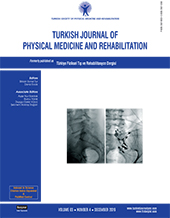The relationship of illness perceptions with demographic features, pain severity, functional capacity, disability, depression, and quality of life in patients with chronic low back pain
2 Department of Physical Medicine and Rehabilitation, Ondokuz Mayıs University Medical Faculty, Samsun, Turkey
3 Department of Physical Medicine and Rehabilitation, Acıbadem Bakırköy Hospital, İstanbul, Turkey
4 Faculty of Science and Arts-Department of Statistics, Ondokuz Mayıs University, Samsun, Turkey DOI : 10.5606/tftrd.2019.3248 Objectives: The aim of this study was to evaluate the relationship of illness perceptions (IPs) with demographic features, severity of pain, functional capacity, disability, depression, and quality of life in patients with chronic low back pain (CLBP).
Patients and methods: Between January 2015 and July 2015, a total of 114 patients with non-specific CLBP (86 females, 28 males; mean age 47.1±15.2 years; range, 18 to 85 years) were included. Non-specific CLBP was defined as low back pain not attributable to a recognizable, known specific pathology such as infection, tumor, inflammation for ≥12 weeks. The IPs using the revised Illness Perception Questionnaire (IPQ-R), pain severity using the visual analog scale (VAS), functional capacity using the Six-Minute Walk Test (6MWT), disability using the modified Oswestry Disability Index (m-ODI), depression using the Beck Depression Inventory (BDI), and quality of life using the Short Form-36 (SF-36) were assessed.
Results: There was a significant, positive correlation between the age, body mass index, duration of disease, pain scores, and IPQ-Rconsequences, timeline (acute/chronic), and emotional responses subunits, whereas there was a significant, negative correlation between the IPQ-R-personal and treatment control subunits (p<0.001). The IPQ-R-timeline (acute/chronic), consequences, and emotional response subunits were positively and personal and treatment controls and illness coherence subunits were negatively correlated with the BDI and m-ODI (p<0.001). The IPQ-R-consequences and emotional responses subunits were negatively and timeline (acute/chronic), personal and treatment controls, and illness coherence subunits were positively correlated with the SF-36 subunits (p<0.05).
Conclusion: The IPs were negatively affected by advanced age, high body mass index, longer duration of disease, and increased severity of pain in CLBP patients. Based on these findings, positive IPs may be related with reduced disability and depression, and improved quality of life and functional capacity in this patient population. Developing new strategies for improving the negative IPs of patients with CLBP may be useful.
Keywords : Depression, disability, illness perception, low back pain, quality of life
















